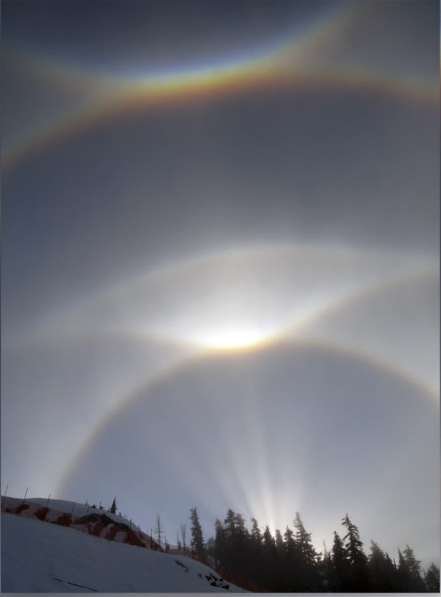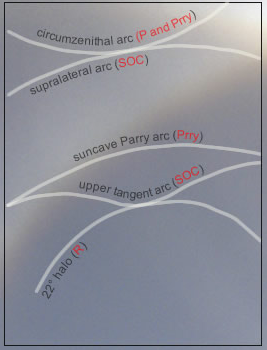4 out of 5
Why Are Halos So Reproducible and Geometrically Exact?
Halos, those captivating atmospheric optical phenomena, possess a remarkable reproducibility and geometric precision. This fascinating characteristic can be attributed to two primary factors: the fixed and accurate geometries of ice crystals and the precise alignment of these crystals through aerodynamic drag forces.
Ice crystals possess well-defined shapes that mirror their internal atomic order. These geometries remain consistent, allowing for the replication of halos with great accuracy. The aerodynamic drag forces generated as the crystals descend play a crucial role in aligning them precisely. This alignment ensures that the halos formed by the crystals exhibit a predictable and consistent appearance.
Intriguingly, despite the immense variety of ice crystal shapes and orientations, as few as five main orientations can account for nearly all the observed halos. While scientists have theorized the existence of other orientations and their corresponding halos, they have yet to be observed in nature. The current understanding of halos is built upon these five main orientations, which have been extensively studied and documented.
The captivating image captured by David Hayes in Whistler B.C., Canada, showcases a stunning display of halos. Four out of the five main orientations were present in this display, as confirmed by the presence of parhelia in other images, indicating the presence of plate crystals. The elusive Lowitz orientation, however, was absent from this particular observation.
To delve further into the intricacies of ice crystal orientations and their corresponding halos, it is essential to understand the distinct characteristics of each orientation:
-
Randomly Oriented Crystals: These crystals can point in any direction due to their lack of a dominant alignment axis.
-
Plates: Plate crystals have their main axis oriented vertically. This orientation contributes to the formation of specific halo patterns associated with plate crystals.
-
Singly Oriented Columns (SOCs): SOCs have their main axis aligned horizontally and can rotate around it. This rotational ability gives rise to distinct halo phenomena.
-
Parry Oriented Crystals: Similar to SOCs, Parry oriented crystals have their main axis horizontally aligned. However, these crystals also possess a horizontal top face, further influencing the formation of unique halos.
-
Lowitz Crystals: Lowitz crystals exhibit rotational positions around a horizontal axis that intersects opposite prism edges. The presence of Lowitz orientation contributes to the creation of specific halo patterns not observed in other orientations.
The study of halos and ice crystal orientations continues to be an active field of research. Scientists strive to uncover the underlying mechanisms that govern the formation of these optical wonders. Through a combination of theoretical predictions and observational data, researchers aim to expand our understanding of halos and potentially discover new orientations and their corresponding halos.
While halos are often associated with cold and icy regions, they can occur in various atmospheric conditions. The presence of ice crystals, whether in cirrus clouds or high-altitude contrails, provides the necessary elements for halo formation. By studying halos, scientists gain valuable insights into atmospheric processes and the properties of ice crystals, contributing to our broader understanding of Earth's climate system.
In conclusion, the reproducibility and geometric precision of halos can be attributed to the fixed geometries of ice crystals and the precise alignment facilitated by aerodynamic drag forces. The existence of as few as five main orientations can account for the vast majority of observed halos. However, the potential for undiscovered orientations and their corresponding halos adds an element of excitement and intrigue to the study of atmospheric optics. Through ongoing research and observation, scientists aim to unravel the mysteries surrounding halos and further expand our knowledge of these captivating natural phenomena.

Halos at Whistler B.C. Canada captured by David Hayes.
©David Hayes.
Why are halos so reproducible and geometrically exact?
Two reasons. Ice crystals have fixed and accurate geometries that echo their internal atomic order. The crystals are aligned very precisely by aerodynamic drag forces generated as they drift downwards.
Rather satisfyingly, as few as five main orientations are able to explain nearly all the halos ever observed. We can think of others and predict their halos - but they have not been observed in Nature - yet.
This display had four of the orientations (parhelia on other images confirm that plate crystals were present), only the elusive Lowitz orientation was missing.

Randomly oriented crystals point in any direction. Plates have the main crystal axis vertical. Singly oriented columns (SOCs) have the main axis horizontal and can rotate around it.
Parry oriented crystals also have the main axis horizontal but the crystal also has its top face horizontal.
Lowitz crystals can take rotational positions about a horizontal axis crossing opposite prism edges.

Note: this article has been automatically converted from the old site and may not appear as intended. You can find the original article here.
Reference Atmospheric Optics
If you use any of the definitions, information, or data presented on Atmospheric Optics, please copy the link or reference below to properly credit us as the reference source. Thank you!
-
<a href="https://atoptics.co.uk/blog/4-out-of-5/">4 out of 5</a>
-
"4 out of 5". Atmospheric Optics. Accessed on November 15, 2024. https://atoptics.co.uk/blog/4-out-of-5/.
-
"4 out of 5". Atmospheric Optics, https://atoptics.co.uk/blog/4-out-of-5/. Accessed 15 November, 2024
-
4 out of 5. Atmospheric Optics. Retrieved from https://atoptics.co.uk/blog/4-out-of-5/.